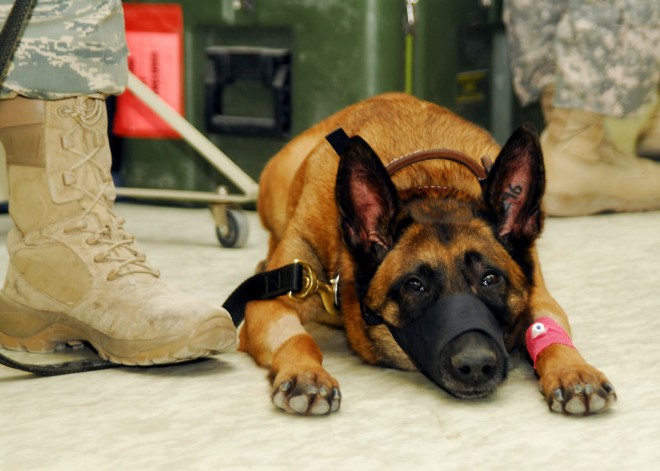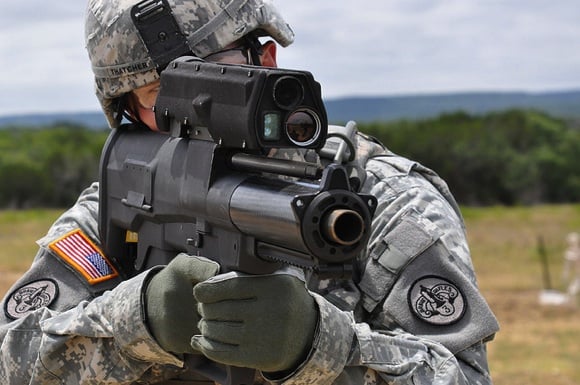- Comms
- Law
- Medic
- News
- Opinion
- Threat Watch
- Training
- Warrior Tools
- Accessories
- Ammo
- Body Armor
- Books
- Clothing
- Commo
- Gear
- Handguns
- Holsters
- Knives
- Long Guns
- ACC
- Accuracy International
- Barrett
- Benelli
- Beretta
- Blaser
- Bushmaster
- Custom
- CZ
- Desert Tactical Arms
- DPMS
- FN
- Forums
- HK
- IWI
- Kel-Tec Long Guns
- LaRue
- LWRC
- McMillan
- Mosin Nagant
- Mossberg
- Para
- Remington
- Rock River Arms
- Ruger Long Guns
- Sabre Defense
- Sako
- SIG Sauer
- SKS
- Smith & Wesson Long Guns
- Springfield
- Styer
- Weatherby
- Wilson Combat
- Winchester
- Magazines
- Maintenance
- Navigation
- Optics
- Sights
- Tech
- Warriors
Posts Tagged afghanistan
U.S. Navy Divers Recover Body of Soldier From Afghanistan River
Posted by Jack Sinclair in News, Warriors on 23/Oct/2010 16:42

Members of a U.S. Navy dive team from Mobile Diving and Salvage Unit 2 drag a Zodiac inflatable boat up a river in Afghanistan that they have been searching. Members of a U.S. Navy dive team from Mobile Diving and Salvage Unit 2 along with members of the U.S. Army 82nd Airborne are currently participating in Operation Hero Rescue attempting to recover the body of U.S. Army Sgt Brandon Islip lost in a river in Afghanistan after going in the water Nov. 4, 2009. (U.S. Navy Photo by Mass Communication Specialist 1st Class Matthew Bash)
U.N. says security forces fought off attack in Herat, Afghanistan
Posted by Jack Sinclair in News on 23/Oct/2010 15:00
Kabul, Afghanistan (CNN) — “The U.N. in Afghanistan said security forces on Saturday thwarted an attack on its Herat compound in western Afghanistan.
A Herat provincial official said three or four armed militants clad in suicide vests were killed Saturday after they attacked the U.N. compound. At least two Afghan security officers were injured in the strike, the United Nations said.”
http://edition.cnn.com/2010/WORLD/asiapcf/10/23/afghanistan.un/
Afghan National Police and U.S. Troops Search for Caches in Khowst Province
Posted by Jack Sinclair in News, Warriors on 21/Oct/2010 22:42
Patrol in Khost Province, Afghanistan
Posted by Jack Sinclair in News, Warriors on 21/Oct/2010 22:40
Guerrilla Trucks: why the Toyota Hilux pickup is the AK-47 of vehicles
Posted by Jack Sinclair in News on 21/Oct/2010 22:34
“As the war in Afghanistan escalated several years ago, counterinsurgency expert David Kilcullen, a member of the team that designed the Iraq surge for Gen. David Petraeus, began to notice a new tattoo on some insurgent Afghan fighters. It wasn’t a Taliban tattoo. It wasn’t even Afghan. It was a Canadian maple leaf.
When a perplexed Kilcullen began to investigate, he says, he discovered that the incongruous flags were linked to what he says is one of the most important, and unnoticed, weapons of guerrilla war in Afghanistan and across the world: the lightweight, virtually indestructible Toyota Hilux truck.
“In Afghanistan in particular,†he says, “[the trucks are] incredibly well respected.â€
http://www.newsweek.com/2010/10/14/why-rebel-groups-love-the-toyota-hilux.html
A Year at War
Posted by Jack Sinclair in News on 21/Oct/2010 22:22
Some 30,000 American soldiers are taking part in the Afghanistan surge. Here are the stories of the men and women of First Battalion, 87th Infantry of the 10th Mountain Division. Over the next year, The New York Times will follow their journey.
http://www.nytimes.com/interactive/world/battalion.html#/NYT/0
HIMARS rockets video footage: Afghani locals “talk with awe of a powerful new rocketâ€
Posted by Jack Sinclair in News on 21/Oct/2010 19:40
Amazingly, just a few months after NATO and Afghan troops gradually stepped up operations in the Taliban heartland of Kandahar, the insurgents have fled, with a return unlikely.
If pronouncements like “We broke their neck†from the Afghan police commander of Argandab district seem premature, consider this: The NATO general in charge of the area credits a new miracle rocket with helping turn the tide and it has been in Afghanistan for a while.
The Times‘ veteran Afghanistan correspondent Carlotta Gall writes that locals “talk with awe of a powerful new rocket†that NATO’s used to batter Taliban outposts in Panjwai “with remarkable accuracy.â€
NATO general credits new miracle rocket with helping turn the tide in Afghanistan
Posted by Jack Sinclair in News on 21/Oct/2010 19:37
“HIMARS use is tightly-regulated, precisely because it’s so powerful. Sitting on the back of a 5-ton truck, HIMARS is capable of firing a single, 13-foot ATACMS surface-to-surface missile 100 miles or more away.
Or, it can pound up to half-dozen GPS-guided rockets in a matter of seconds at at a single target more than 40 miles in the distance; that’s more than double the range of a traditional howitzer.
“The advantage of HIMARS is that is can put a lot of firepower downrange very, very quickly,†an Army fire support officer told Danger Room in February.
It’s so much firepower, in fact, that, for a while in Afghanistan, air strikes were easier to authorize than HIMARS. (At least the air assaults had overhead intelligence to back ‘em up.)”
Read More http://www.wired.com/dangerroom/2010/10/did-a-new-rocket-help-rout-the-taliban-depends-what-you-mean-by-new-and-rout/#ixzz132kbR3YP
$19 Billion Later, Pentagon’s Best Bomb-Detector Is a Dog
Posted by Jack Sinclair in News on 21/Oct/2010 19:29
“Drones, metal detectors, chemical sniffers, and super spycams — forget ‘em. The leader of the Pentagon’s multibillion military task force to stop improvised bombs says there’s nothing in the U.S. arsenal for bomb detection more powerful than a dog’s nose.
Despite a slew of bomb-finding gagdets, the American military only locates about 50 percent of the improvised explosives planted in Afghanistan and Iraq. But that number jumps to 80 percent when U.S. and Afghan patrols take dogs along for a sniff-heavy walk. “Dogs are the best detectors,†Lieutenant General Michael Oates, the commander of the Joint Improvised Explosive Device Defeat Organization, told a conference yesterday.”
$19 Billion Later, Pentagon’s Best Bomb-Detector Is a Dog | Danger Room | Wired.com.
Coalition Routs Taliban in Southern Afghanistan
Posted by Jack Sinclair in News, Threat Watch, Warriors on 21/Oct/2010 01:06

Joao Silva for The New York Times An American soldier looked out Tuesday from a guard post in Arghandab, Afghanistan, a strategic district in Kandahar Province north of the city of Kandahar.
“ARGHANDAB, Afghanistan — American and Afghan forces have been routing the Taliban in much of Kandahar Province in recent weeks, forcing many hardened fighters, faced with the buildup of American forces, to flee strongholds they have held for years, NATO commanders, local Afghan officials and residents of the region said.
Some of the gains seem to have come from a new mobile rocket that has pinpoint accuracy — like a small cruise missile — and has been used against the hideouts of insurgent commanders around Kandahar. That has forced many of them to retreat across the border into Pakistan.
Disruption of their supply lines has made it harder for them to stage retaliatory strikes or suicide bombings, at least for the moment, officials and residents said.”
http://www.nytimes.com/2010/10/21/world/asia/21kandahar.html?_r=1
Lance Cpl. Ashley M. Rockhold, driver with 4th Platoon, Military Police Company
Posted by Jack Sinclair in News, Warriors on 20/Oct/2010 17:37
.jpg)
Lance Cpl. Ashley M. Rockhold, driver with 4th Platoon, Military Police Company, Combat Logistics Regement 17, 1st Marine Logistics Group, is a unique asset to her unit. Rockhold, from Linesville, Iowa, has her explosive license to haul ammunition for her unit. Marines with Military Police Co. are currently training for their upcoming deployment to Afghaistan.
Patrol near Checkpoint North in Helmand province
Posted by Jack Sinclair in News, Warriors on 20/Oct/2010 17:35
.jpg)
Lance Cpl. Dustin Thompson, a radio operator with Firepower Control Team Alpha, 1st Brigade Platoon, 2nd Air Naval Gunfire Liaison Company, Marine Expeditionary Brigade-Afghanistan, sits in an irrigation canal with Cpl. Tim Barney, a forward observer with FCT-A, during a patrol, Sept. 23, near Checkpoint North in Helmand province, Afghanistan. The patrol took the soldiers and Marines through fields of crops and through waist-high irrigation canals from the checkpoint down to another U.K. post known as Tapa Parang and back up to the checkpoint. Photo by Cpl. Aaron Rooks
Afghan Rules of Engagement
Posted by Brian in News, Threat Watch, Warriors on 20/Oct/2010 14:49
From the Washington Examiner:
“I don’t think the military leaders, president or anybody really cares about what we’re going through,” said Spc. Matthew “Silver” Fuhrken, 25, from Watertown, N.Y. “I’m sick of people trying to cover up what’s really going on over here. They won’t let us do our job. I don’t care if they try to kick me out for what I’m saying — war is war and this is no war. I don’t know what this is.”
We need to figure out if we want the civilians to like us or if we want to kill the enemy. Right now it seems like we are trying to do a little of both and succeeding at neither.
Futuristic Judge Dredd smartguns issued to 101st Airborne
Posted by Jack Sinclair in News, Warriors on 15/Oct/2010 18:23
“It’s all go in the world of futuristic Judge Dredd style guns today. Reports suggest that a battalion of US airmobile* troops in Afghanistan are to be equipped with the XM-25 computing smart-rifle, able to strike enemies hiding round corners or in trenches.
A successful “proof of concept” of a guided homing bullet for use in sniper rifles has also been announced.”
NATO’s Lack of a Strategic Concept
Posted by Brian in News, Opinion, Threat Watch on 12/Oct/2010 16:14
NATO’s Lack of a Strategic Concept is republished with permission of STRATFOR.
By Marko Papic
Twenty-eight heads of state of the North Atlantic Treaty Organization (NATO) will meet in Lisbon on Nov. 20 to approve a new “Strategic Concept,†the alliance’s mission statement for the next decade. This will be NATO’s third Strategic Concept since the Cold War ended. The last two came in 1991 — as the Soviet Union was collapsing — and 1999 — as NATO intervened in Yugoslavia, undertaking its first serious military engagement.
During the Cold War, the presence of 50 Soviet and Warsaw Pact armored divisions and nearly 2 million troops west of the Urals spoke far louder than mission statements. While Strategic Concepts were put out in 1949, 1952, 1957 and 1968, they merely served to reinforce NATO’s mission, namely, to keep the Soviets at bay. Today, the debate surrounding NATO’s Strategic Concept itself highlights the alliance’s existential crisis. Read the rest of this entry »




